TS
bangmono
Göteborg's Secret Cold War Base (Sweden)
GOTEBORG, Sweden (May 24, 2009) -- I arrived in Göteborg from Stockholm after a comfortable 3-hour, 1st class ride on the modern X2000 highspeed train and immediately headed to an interesting underground Cold War site in Göteborg, Sweden. This once secret installation is located at Säve Depå, on the property of the current civilian Göteborg City Airport, about 15 minutes northwest of downtown.
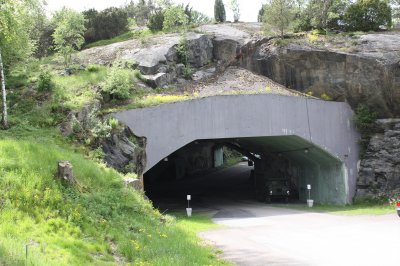
Above: Hardened east outer entrance of the underground shelter.
The former military facility is best known for its 22,000 square meter hardened aircraft shelter (HAS), built in the early 1950s to protect combat aircraft from the Göta Wing (F 9) of the Royal Swedish Air Force. An 8,000 square meter shelter is also at the base, though the larger one is currently open to tours by the Aeroseum Foundation. The Swedish Defence Ministry declassified the base in 1999 and in 2008, the Aeroseum became part of the national historical preservation network of Swedish Military Heritage (For a diagram of the HAS, click here; for a Map/Satellite image, click here or [URL="http://maps.live.com/default.aspx?v=2&cp=57.778391~11.884847&style=o&lvl=1&tilt=-90&dir=0&alt=-1000&scene=15564051&encType=1"]here[/URL]).
The F 9 Säve fighter wing was commissioned in 1940 and the first rock shelter at was completed in 1942. This is among the world's oldest shelter of its kind (Switzerland and Italy developed these a few years earlier) and was initially used to protect Italian-built fighter Fiat CR 42 biplanes, among other aircraft. At the height of the Cold War in the 1950s, the base was greatly expanded with new, deeper and better protected tunnels, which were used for over ten years to house the SAAB J 29 "Tunnan" combat jets. The wing was decommissioned in 1969.
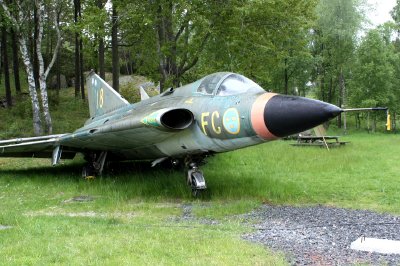
Above: An aged JA 35 Draken fighter bomber greets visitors at the entrance to the once secret aircraft bunker.
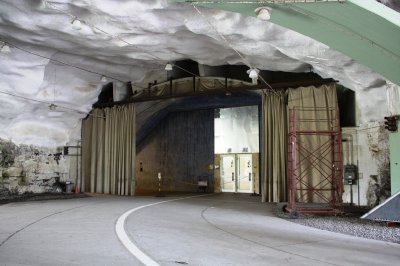
Above and below: Hardened main tunnel entrance with 24-inch thick concrete sliding doors.
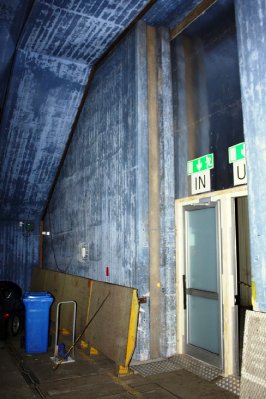
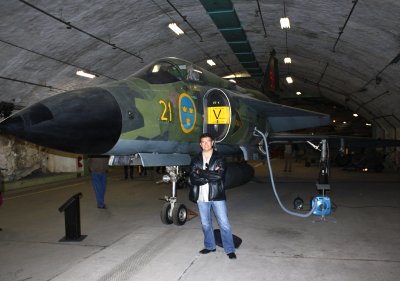
Above: I'm standing next to a Saab JA 37 Viggen, a Swedish fighter plane that was ahead of its time in the 1970s/80s. Its double delta configuration is similar to several of today's state-of-the-art fighter aircraft such as the Eurofighter Typhoon, Rafale and its Swedish Air Force successor, the Gripen.
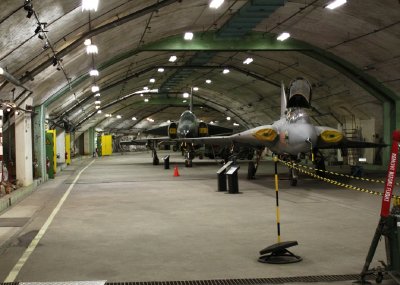
Above: A Saab JA 35 Draken (foreground) and a Saab JA 37 Viggen (background).
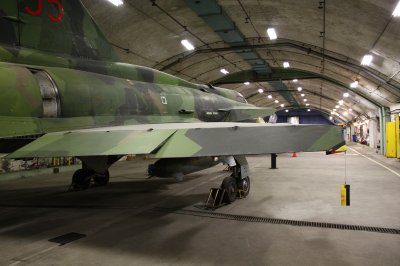
Above and below: Back end of the Saab JA 37 Viggen. The Viggen was powered by a single Volvo RM8 turbofan, which was essentially a licence-built version of the Pratt & Whitney JT8D engine, except that the Viggen engine included an afterburner and a thrust-reverser. The thrust-reverser gave the Viggen near-STOL capabilities, allowing the aircraft to easily handle landing and takeoff on short runways and highways (under 500 meters or 1600 feet). For more information on the Viggen, click here.
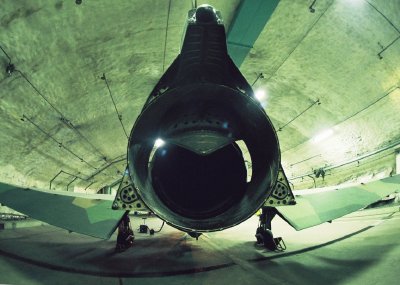
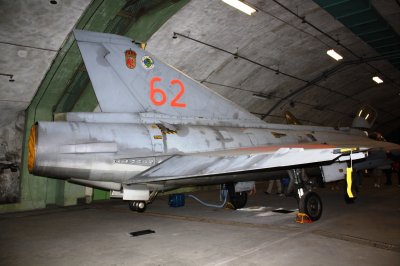
Above: The Saab 35 Draken (meaning "dragon") is a second generation supersonic interceptor with a distinctive double delta wing. The fighter aircraft served in the Swedish Air Force (Flygvapnet) between 1959 and 1974. The Draken was built to replace the Saab J 29 Tunnan and, later, the fighter variant (J 32B) of the Saab 32 Lansen. The indigenous J 35 was an effective supersonic Cold War fighter plane. A total of about 640 Drakens were built. Export customers included Denmark and Finland. In 1985, the Austrian Air Force purchased 24 J 35D s reconditioned by Saab. It was retired from Swedish services in 1999. Today, the U.S. Navy and the Airborne Tactical Advantage Company (ATAC) use retired Drakens for pilot training. For more information on the Draken, cclick here.
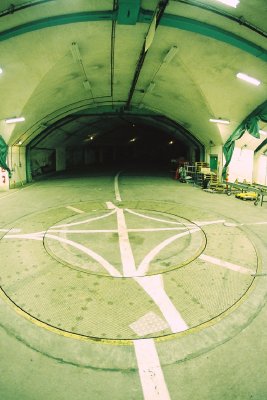
Above: The west end of the HAS has a rotating platform to facilitate aircraft maneuvering.

Above: Inside the cockpit of the JA 37 Viggen.
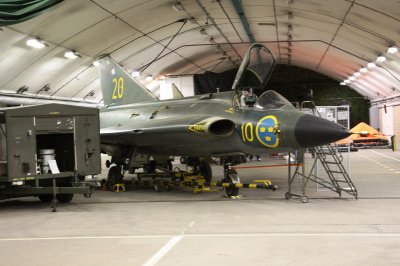
Above: A green colored Saab J 35 Draken.
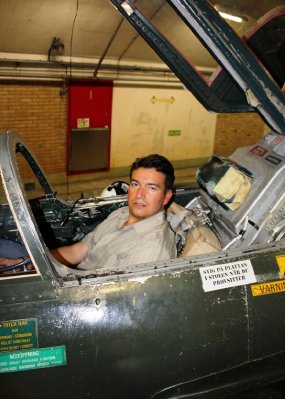
Above: In the cockpit of a J 35 Draken.
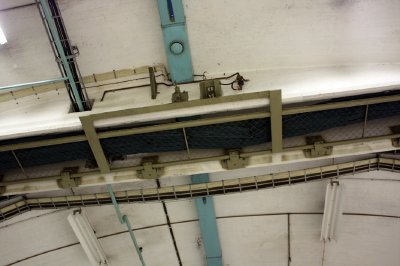
Above: In the event of a fire or explosion, these fire resistant curtains were designed to fall from various tunnel section dividers to reduce damage and the speed of smoke buildup.
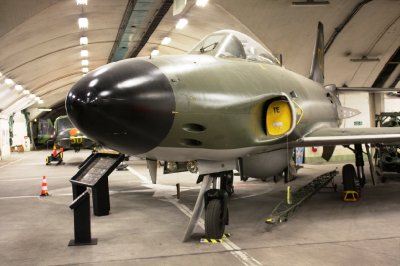
Above and below: A Saab 32E Lansen is a two-seater attack aircraft that served the Swedish Air Force (Flygvapnet) between 1955 to 1978. The aircraft was used in multiple roles, including as a fighter, reconnaissance, electronic warfare and even as a target-tug aircraft. Over 400 of the aircraft were built.
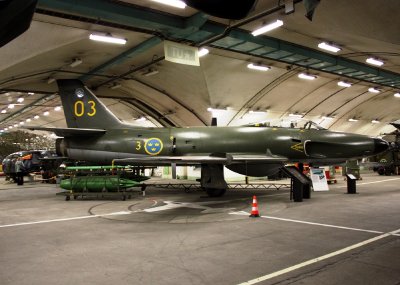

Above ang below: The command center in the HAS, which did not include radar monitors, but rather relied of communications with pilots and ground observers to control traffic.
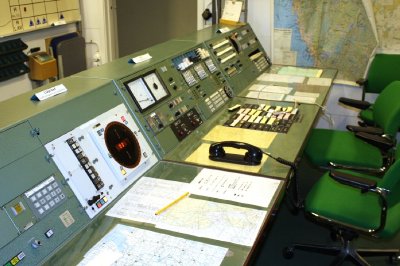
Above: A wall diagram of the entire underground complex, showing the tunnels, command and control rooms, storage and other operational areas.
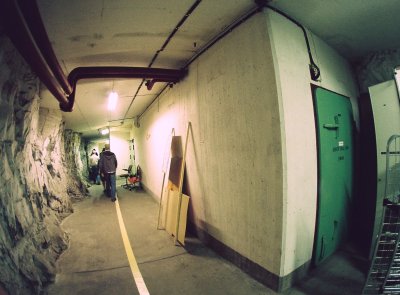
Above: Part of the concrete passageways leading from the command center.
During the 1950s, the Swedish Air Force built multiple road bases to disperse their aircraft and increase survivability of squadrons. The bases consisted of stretches of main roads and highways constructed to serve as landing strips, with underground fuel tanks, communications bunkers and other necessary infrastructure. During that period Sweden had one of the most powerful air forces in Western Europe, both numerically and qualitatively, and posed a serious challenge for Soviet Air Force planning in the Baltic region.
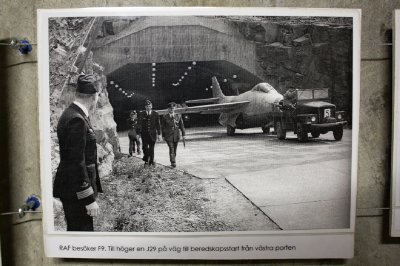
Above: The Aeroseum displays numerous photographs of what the facility looked like in its prime. In this picture, a J 29 Tunnan fighter is wheeled out of the shelter toward the taxiway in the presence of visiting dignitaries and senior officers (circa 1950s).
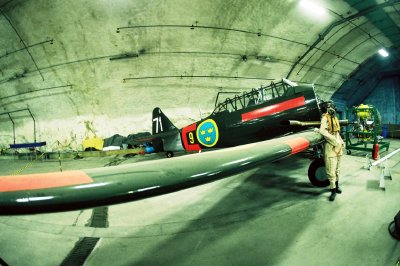
Above: This is one of 146 Canadian-built North American Harvard Mk IIB (Sk 16, reg. Fv 16068) that entered service with the Swedish Air Force in 1947. A second batch of variants of the original aircraft was purchased in the early 1950s and were designated Sk 16B and Sk 16C. Although these later models were retired in the late 1950s, a few of the earlier Sk 16A kept flying until the early 1970s.
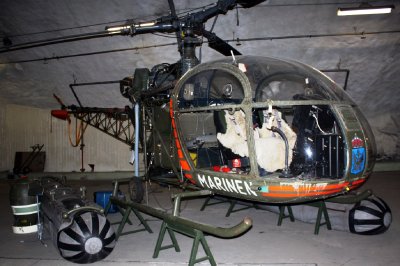
Above: The Sud Aviation SE 3130 Alouette II (Hkp 2, reg. Fv 02036, Marinen) was one of 13 to serve in the Swedish Navy between between 1959 and 1985. The helicopter was used for liaison, sea survey, rescue and also for anti-submarine warfare (ASW). The large bubble canopy gave the pilots excellent visibility. During its service, the helicopter was often deployed on navy vessels, such as the destroyer HMS Småland.

Above: This Agusta Bell 206B Jet Ranger (Hkp 6B, reg. Fv 06051) was one of 32 Jet Rangers acquired in two versions for the Swedish military. Eleven helicopters for the Army were ordered (designated HKP 6A) along with ten for the Navy (designated HKP 6B). These were all built under by Agusta in Italy. The last ones were retired from service in 2004.
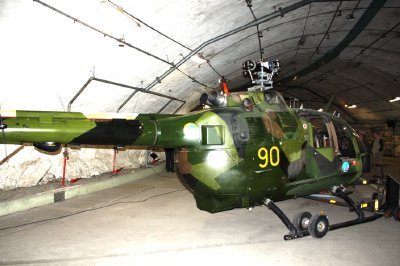
Above: A German built MBB BO 105 helicopter (designated HKP 9, reg. Fv 09221 "FC-90") used in the Swedish military.

Above: Spare engines for the Viggen and Draken fighters are visible in this shot along with a Draken fighter aircraft.

Above: A Falcon missile on a stand and a Draken fighter-bomber loaded with three external fuel tanks.
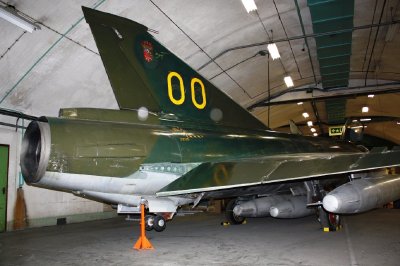
Above: The tail of a Draken, showing the small rear gear, which protected the lower fuselage from hitting the ground during take-off and landing.

Above: The cockpit of a JA 35 Draken.
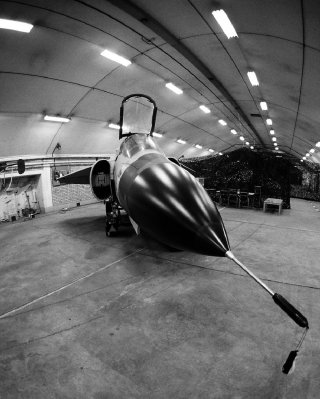
Above: The nose cone of the JA 37 Viggen that housed the multi-mode, pulse-Doppler Ericsson PS 46/A radar optimized for the fighter/interceptor role. The radar incorporated lookdown/shootdown capability, with a range up to 50 km, continuous-wave illumination for Skyflash missiles.

Above: The tandem wheel landing gear of the JA 37 Viggen was designed in part to better handle rough airfield operations. A similar landing gear arrangement is found on today's Russian MiG-31.
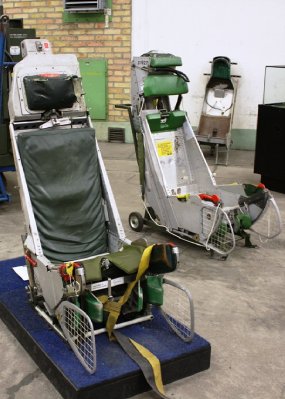
Above: The ejection seats of a Draken (foreground) and Viggen (back).
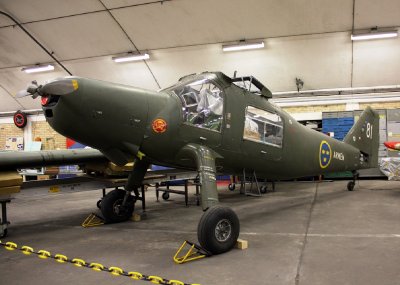
Above: This Dornier 27 (reg. 53271) first flew in the mid 1950s and was known for its ability to land and take off from short, rough fields and roads. It was used in particular for reconnaissance, transport and parachute jumping. Recently donated to the Aeroseum, it will likely be restored to flying condition in the near future.

Above: The SAAB Safir (reg. SE-AUR) is best known as a trainer aircraft and was sold to more than 20 countries. The SAAB 91A model was the early version ordered by the Swedish Air Force and was designated Tp 91 for its transport/liaison duties. Later versions included the 91B and 91C, and a total of 323 Safirs were built. Prior to being brought to the Aeroseum, this aircraft was displayed suspended in the terminal building of Goteborg’s Landvetter Airport.
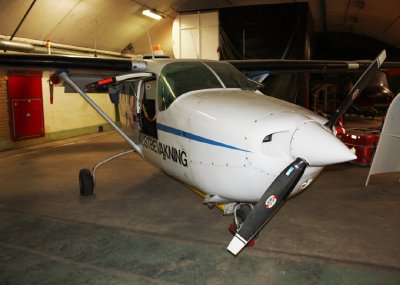
Above: This aircraft is a Cessna/Reims 337G Super Skymaster (reg. SE-GMM) used by the Swedish Coast Guard (the Kustbevakningen).
Sweden has operated other hardened mountain shelters, such as F 13 Norrköping, F 18 Tullinge, F 16 Uppsala, F 8 Barkarby, Fällfors and Arboga, all of which were expanded to house Drakens and/or Viggens, and some of the development resulted from consultations with the Swiss Air Force, which operated aircraft tunnels at seven airbases during the Cold War. Although the underground facility in Goteborg is decommissioned, as are all but one in Sweden, a large number of similar facilities are still in operation around the world, including in China, Taiwan, North Korea, Switzerland (Meiringen Air Base), Saudi Arabia, and former Yugoslavia. During the NATO-Serbian conflict, the U.S. targeted aicraft tunnels in Bihac and Pristina, but the air dropped weapons were not able to damage the interior of the Pristina HAS, showing that such aircraft protection systems are still viable if located under enough rock.
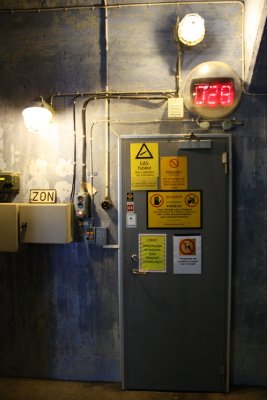
Above: One of the shelter's personnel doorways at the east aircraft entrance.

Above: The underground facility required substantial infrastructure to operate and to allow personnel to live inside for extended periods in case of war. This infrastructure included among others ventilation, air filtration, electrical, fuel, oil and gas storage, fire suppression, and water purification systems.

Above: one of the two taxiways that lead aircraft from the HAS to the runway.

Above: Remnants of the air filtration and ventilation systems that were vital to the underground shelter.
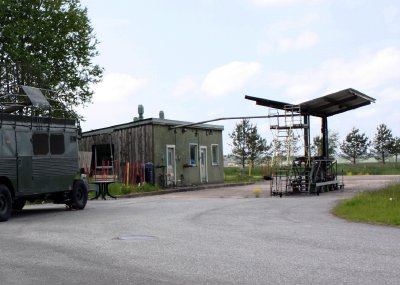
Above and below: The main fuel facility for the HAS.
Sumber
------------------------------------------------------------------------------------------------------------------------
ada yg punya info Secret Cold War Base dari blok timur ?

Above: Hardened east outer entrance of the underground shelter.
The former military facility is best known for its 22,000 square meter hardened aircraft shelter (HAS), built in the early 1950s to protect combat aircraft from the Göta Wing (F 9) of the Royal Swedish Air Force. An 8,000 square meter shelter is also at the base, though the larger one is currently open to tours by the Aeroseum Foundation. The Swedish Defence Ministry declassified the base in 1999 and in 2008, the Aeroseum became part of the national historical preservation network of Swedish Military Heritage (For a diagram of the HAS, click here; for a Map/Satellite image, click here or [URL="http://maps.live.com/default.aspx?v=2&cp=57.778391~11.884847&style=o&lvl=1&tilt=-90&dir=0&alt=-1000&scene=15564051&encType=1"]here[/URL]).
The F 9 Säve fighter wing was commissioned in 1940 and the first rock shelter at was completed in 1942. This is among the world's oldest shelter of its kind (Switzerland and Italy developed these a few years earlier) and was initially used to protect Italian-built fighter Fiat CR 42 biplanes, among other aircraft. At the height of the Cold War in the 1950s, the base was greatly expanded with new, deeper and better protected tunnels, which were used for over ten years to house the SAAB J 29 "Tunnan" combat jets. The wing was decommissioned in 1969.

Above: An aged JA 35 Draken fighter bomber greets visitors at the entrance to the once secret aircraft bunker.

Above and below: Hardened main tunnel entrance with 24-inch thick concrete sliding doors.


Above: I'm standing next to a Saab JA 37 Viggen, a Swedish fighter plane that was ahead of its time in the 1970s/80s. Its double delta configuration is similar to several of today's state-of-the-art fighter aircraft such as the Eurofighter Typhoon, Rafale and its Swedish Air Force successor, the Gripen.

Above: A Saab JA 35 Draken (foreground) and a Saab JA 37 Viggen (background).

Above and below: Back end of the Saab JA 37 Viggen. The Viggen was powered by a single Volvo RM8 turbofan, which was essentially a licence-built version of the Pratt & Whitney JT8D engine, except that the Viggen engine included an afterburner and a thrust-reverser. The thrust-reverser gave the Viggen near-STOL capabilities, allowing the aircraft to easily handle landing and takeoff on short runways and highways (under 500 meters or 1600 feet). For more information on the Viggen, click here.


Above: The Saab 35 Draken (meaning "dragon") is a second generation supersonic interceptor with a distinctive double delta wing. The fighter aircraft served in the Swedish Air Force (Flygvapnet) between 1959 and 1974. The Draken was built to replace the Saab J 29 Tunnan and, later, the fighter variant (J 32B) of the Saab 32 Lansen. The indigenous J 35 was an effective supersonic Cold War fighter plane. A total of about 640 Drakens were built. Export customers included Denmark and Finland. In 1985, the Austrian Air Force purchased 24 J 35D s reconditioned by Saab. It was retired from Swedish services in 1999. Today, the U.S. Navy and the Airborne Tactical Advantage Company (ATAC) use retired Drakens for pilot training. For more information on the Draken, cclick here.

Above: The west end of the HAS has a rotating platform to facilitate aircraft maneuvering.

Above: Inside the cockpit of the JA 37 Viggen.

Above: A green colored Saab J 35 Draken.

Above: In the cockpit of a J 35 Draken.

Above: In the event of a fire or explosion, these fire resistant curtains were designed to fall from various tunnel section dividers to reduce damage and the speed of smoke buildup.

Above and below: A Saab 32E Lansen is a two-seater attack aircraft that served the Swedish Air Force (Flygvapnet) between 1955 to 1978. The aircraft was used in multiple roles, including as a fighter, reconnaissance, electronic warfare and even as a target-tug aircraft. Over 400 of the aircraft were built.


Above ang below: The command center in the HAS, which did not include radar monitors, but rather relied of communications with pilots and ground observers to control traffic.

Above: A wall diagram of the entire underground complex, showing the tunnels, command and control rooms, storage and other operational areas.

Above: Part of the concrete passageways leading from the command center.
During the 1950s, the Swedish Air Force built multiple road bases to disperse their aircraft and increase survivability of squadrons. The bases consisted of stretches of main roads and highways constructed to serve as landing strips, with underground fuel tanks, communications bunkers and other necessary infrastructure. During that period Sweden had one of the most powerful air forces in Western Europe, both numerically and qualitatively, and posed a serious challenge for Soviet Air Force planning in the Baltic region.

Above: The Aeroseum displays numerous photographs of what the facility looked like in its prime. In this picture, a J 29 Tunnan fighter is wheeled out of the shelter toward the taxiway in the presence of visiting dignitaries and senior officers (circa 1950s).

Above: This is one of 146 Canadian-built North American Harvard Mk IIB (Sk 16, reg. Fv 16068) that entered service with the Swedish Air Force in 1947. A second batch of variants of the original aircraft was purchased in the early 1950s and were designated Sk 16B and Sk 16C. Although these later models were retired in the late 1950s, a few of the earlier Sk 16A kept flying until the early 1970s.

Above: The Sud Aviation SE 3130 Alouette II (Hkp 2, reg. Fv 02036, Marinen) was one of 13 to serve in the Swedish Navy between between 1959 and 1985. The helicopter was used for liaison, sea survey, rescue and also for anti-submarine warfare (ASW). The large bubble canopy gave the pilots excellent visibility. During its service, the helicopter was often deployed on navy vessels, such as the destroyer HMS Småland.

Above: This Agusta Bell 206B Jet Ranger (Hkp 6B, reg. Fv 06051) was one of 32 Jet Rangers acquired in two versions for the Swedish military. Eleven helicopters for the Army were ordered (designated HKP 6A) along with ten for the Navy (designated HKP 6B). These were all built under by Agusta in Italy. The last ones were retired from service in 2004.

Above: A German built MBB BO 105 helicopter (designated HKP 9, reg. Fv 09221 "FC-90") used in the Swedish military.

Above: Spare engines for the Viggen and Draken fighters are visible in this shot along with a Draken fighter aircraft.

Above: A Falcon missile on a stand and a Draken fighter-bomber loaded with three external fuel tanks.

Above: The tail of a Draken, showing the small rear gear, which protected the lower fuselage from hitting the ground during take-off and landing.

Above: The cockpit of a JA 35 Draken.

Above: The nose cone of the JA 37 Viggen that housed the multi-mode, pulse-Doppler Ericsson PS 46/A radar optimized for the fighter/interceptor role. The radar incorporated lookdown/shootdown capability, with a range up to 50 km, continuous-wave illumination for Skyflash missiles.

Above: The tandem wheel landing gear of the JA 37 Viggen was designed in part to better handle rough airfield operations. A similar landing gear arrangement is found on today's Russian MiG-31.

Above: The ejection seats of a Draken (foreground) and Viggen (back).

Above: This Dornier 27 (reg. 53271) first flew in the mid 1950s and was known for its ability to land and take off from short, rough fields and roads. It was used in particular for reconnaissance, transport and parachute jumping. Recently donated to the Aeroseum, it will likely be restored to flying condition in the near future.

Above: The SAAB Safir (reg. SE-AUR) is best known as a trainer aircraft and was sold to more than 20 countries. The SAAB 91A model was the early version ordered by the Swedish Air Force and was designated Tp 91 for its transport/liaison duties. Later versions included the 91B and 91C, and a total of 323 Safirs were built. Prior to being brought to the Aeroseum, this aircraft was displayed suspended in the terminal building of Goteborg’s Landvetter Airport.

Above: This aircraft is a Cessna/Reims 337G Super Skymaster (reg. SE-GMM) used by the Swedish Coast Guard (the Kustbevakningen).
Sweden has operated other hardened mountain shelters, such as F 13 Norrköping, F 18 Tullinge, F 16 Uppsala, F 8 Barkarby, Fällfors and Arboga, all of which were expanded to house Drakens and/or Viggens, and some of the development resulted from consultations with the Swiss Air Force, which operated aircraft tunnels at seven airbases during the Cold War. Although the underground facility in Goteborg is decommissioned, as are all but one in Sweden, a large number of similar facilities are still in operation around the world, including in China, Taiwan, North Korea, Switzerland (Meiringen Air Base), Saudi Arabia, and former Yugoslavia. During the NATO-Serbian conflict, the U.S. targeted aicraft tunnels in Bihac and Pristina, but the air dropped weapons were not able to damage the interior of the Pristina HAS, showing that such aircraft protection systems are still viable if located under enough rock.

Above: One of the shelter's personnel doorways at the east aircraft entrance.

Above: The underground facility required substantial infrastructure to operate and to allow personnel to live inside for extended periods in case of war. This infrastructure included among others ventilation, air filtration, electrical, fuel, oil and gas storage, fire suppression, and water purification systems.

Above: one of the two taxiways that lead aircraft from the HAS to the runway.

Above: Remnants of the air filtration and ventilation systems that were vital to the underground shelter.

Above and below: The main fuel facility for the HAS.
Sumber
------------------------------------------------------------------------------------------------------------------------
ada yg punya info Secret Cold War Base dari blok timur ?
0
6.1K
13
Thread Digembok
Mari bergabung, dapatkan informasi dan teman baru!
Militer
20KThread•7.1KAnggota
Terlama
Thread Digembok